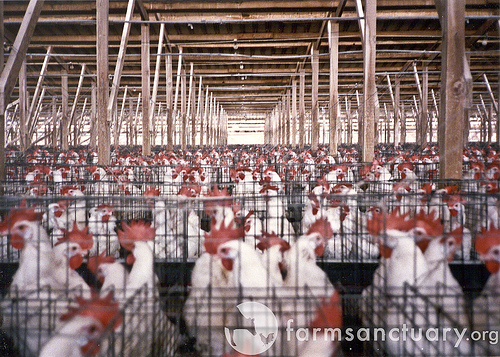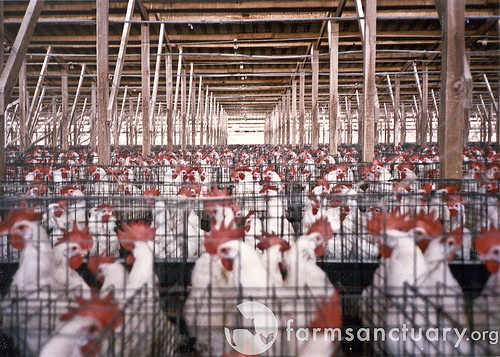 Laying hens in a factory farm.Photo: Farm SanctuaryThere’s nothing like a good salmonella outbreak to inspire FDA inspectors to deliver blunt, graphic reports from inside the industrial food system. When future historians marvel at the fetid, festering underbelly of our food culture, they will relish these post-facto dispatches from the biohazardous front.
Laying hens in a factory farm.Photo: Farm SanctuaryThere’s nothing like a good salmonella outbreak to inspire FDA inspectors to deliver blunt, graphic reports from inside the industrial food system. When future historians marvel at the fetid, festering underbelly of our food culture, they will relish these post-facto dispatches from the biohazardous front.
Back in 2009, a company called Peanut Corporation of America sparked a massive recall involving 4,000 products put out by 360 companies. Nearly 700 people fell ill, half of them children, and nine died. The cause: salmonella-tainted peanut paste. The FDA’s after-the-fact investigation [PDF] of the massive Georgia plant makes riveting reading (for the strong of stomach): moldy water seeping directly into “finished product”; cockroaches running around; processing machinery that routinely went uncleaned, etc. Most shocking of all, the company had several times detected the presence of salmonella in finished product based on its own testing — and sent it out anyway.
Well, the FDA has now competed its post-event investigation of the Iowa egg factories that spawned 550 million salmonella-tainted eggs and have sickened at least 1,500 people. The factories in question are run by Wright County Egg and Hillandale Farms, two of the 10 largest egg producers in the United States. Again, at least for connoisseurs of the grotesque, the results make a fantastic read.
Turns out, the Wright County and Hillandale egg operations, whose products end up on supermarket shelves across the country, are salmonella-ridden, dilapidated hovels characterized by rodent infestations, flies, and, everywhere, feces — both from the laying hens themselves and from wild birds scrounging for free feed.
There are some choice images in the report. To wit, “Dark liquid, which appeared to be manure, was observed seeping through the concrete foundation to the outside of the laying houses at the following locations.” It goes on to name 10 different laying houses, each of which contained hundreds of thousands of birds.
My favorite image of all is this one:
Uncaged birds (chickens having escaped) were observed in the egg laying operation in contact with the egg laying birds … The uncaged birds were using the manure, which was approximately 8 feet high, to access the egg laying area.
If I am envisioning the scene correctly, escaped hens had climbed atop vast shit mounds in order to be high enough to get their beaks into the feed within the cages.
Cross-contamination between the laying houses was evidently rife. “Employees working within the houses did not wear or change protective clothing when moving from house to house,” the FDA inspectors report. “An employee at Layer 6 House 3 was observed walking out of House 3 with a metal scraper and into House 2 without changing protective clothing and without sanitizing equipment between the houses.”
Industrial agriculture is often criticized for wiping out biodiversity — species, whether corn or hens, are raised in vast monocrops. But at Wright County Egg, biodiversity of a certain kind thrived. Inspectors observed between “two and five mice” scampering around at no fewer than 12 laying houses. “Live and dead flies too numerous to count” appeared at 19 houses; and at one house, “live and dead maggots too numerous to count were observed on the manure pit floor.”
If you’re worried about avian flu, you won’t be impressed with Wright County Egg’s efforts to keep wild birds from mingling with laying hens. “Non-chicken feathers” were observed inside one laying house. In another three, “wild birds were observed flying inside.” In an “air vent where the screening was damaged,” pigeons roosted. Gaps and holes in the structures of the laying houses, large enough to let in rodents and wilds birds, are evidently a fact of life. The report complains of “holes in exterior siding, missing siding, holes and/or gaps in the concrete foundation, and air vent screens either missing or damaged.”
Then there’s the whole topic of the facility’s feed mill, which the FDA has fingered as the likely source of the salmonella. Here, the sins of Wright County Egg’s management seemed to combine sinisterly into a virtual incubation house for pathogens. Atop vast mounds of corn destined for the mill, “birds were observed roosting and flying.” Wild birds were so at home that “nesting material was observed in the feed mill … ingredient storage and truck-filling areas.”
And when the inspectors took swabs in and around the mill, they routinely found salmonella. They also found it in the manure mounds building up under the laying houses.
One thing the report doesn’t comment on is the environmental impact of Wright County Egg’s manure management. If the company did such a rotten job keeping its hens from coming into contact with shit, what kind of job did it do keeping that salmonella-rich stuff from seeping into surrounding streams?
At any rate, the conditions described by FDA are wretched and can be counted on to produce biological menaces, salmonella outbreaks counting as just a minor example. The prevailing conditions there will be largely read as the villainy of a single man, Wright County Eggs’ owner, Jack Decoster. Now, Decoster is no doubt quite a piece of work; but as I will show in a later post, his brand of doing business is really the logical outgrowth of a food system that rewards cost-cutting above all else.



